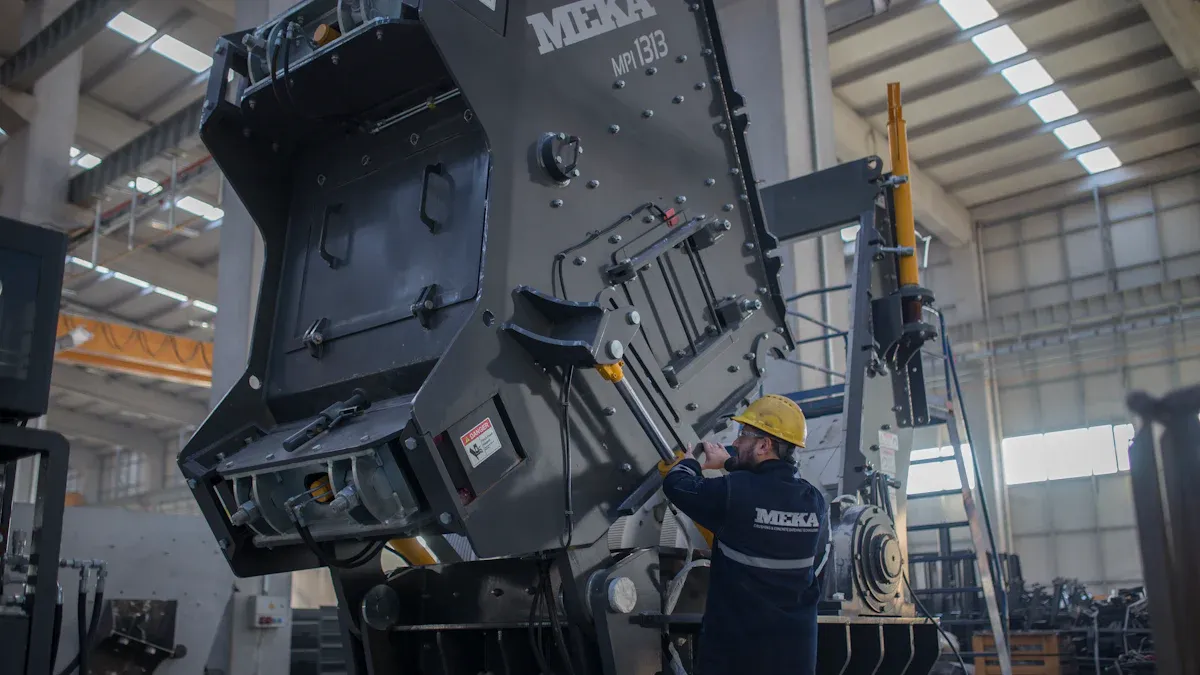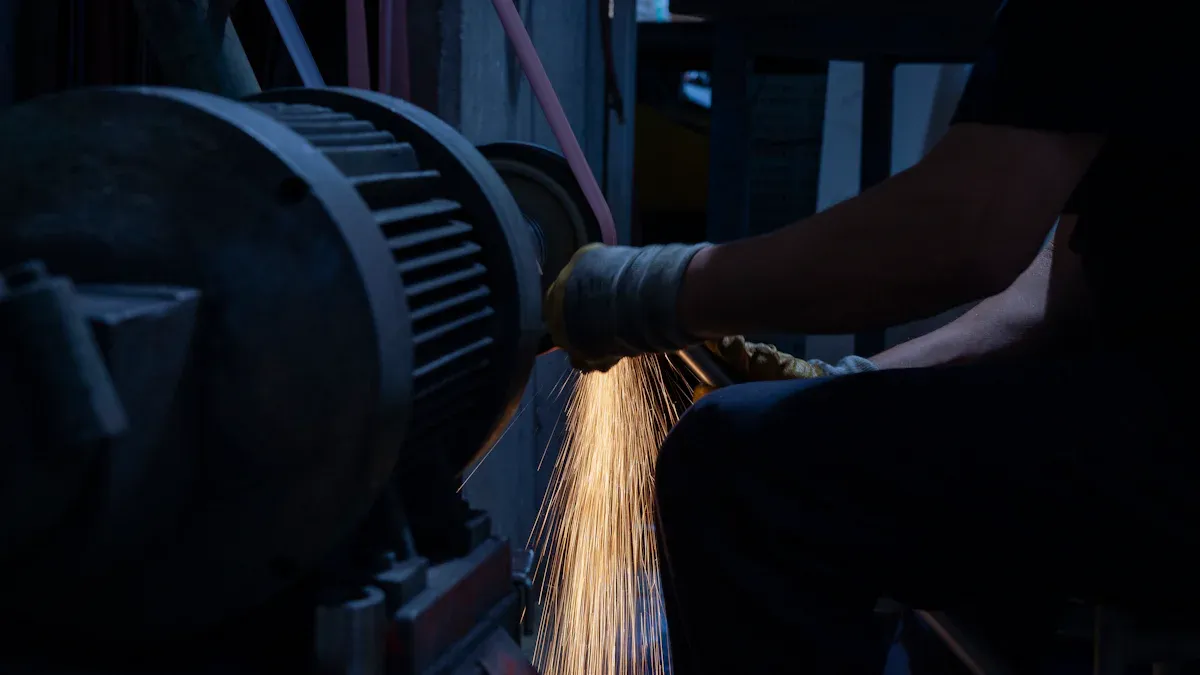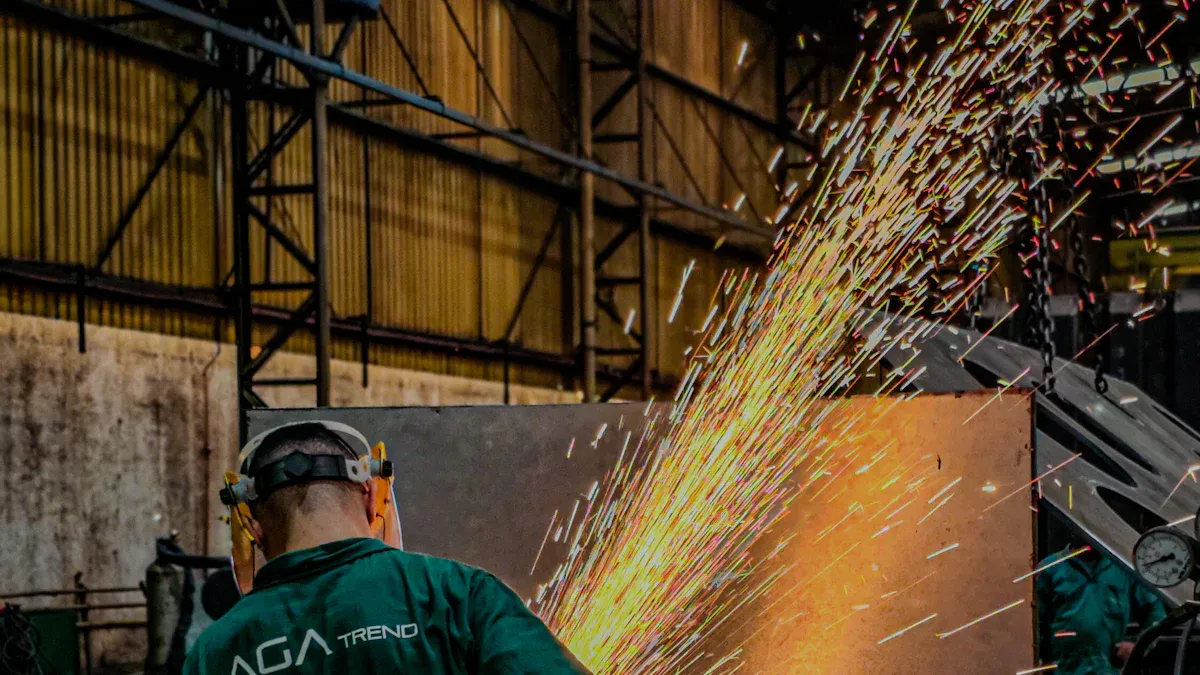
Replacing a worn-out crusher jaw plate ensures your jaw crusher operates efficiently and avoids costly damage. When the jaw plate wears down, its performance declines, leading to reduced durability and productivity. For instance, studies show that the service life of a fixed jaw plate can drop from 150 days to just 63 days, while its output decreases from 750,000 tons to 420,000 tons. These impacts highlight how wear directly affects operational efficiency and output. By addressing this issue promptly, you can maintain the crusher’s performance and extend its lifespan, keeping your operations smooth and cost-effective.
Inspect the jaw plates regularly for visible signs of wear. Cracks, dents, or uneven surfaces indicate that the plates are no longer in optimal condition. These physical damages reduce the crusher's ability to process material effectively. When you notice these issues, it’s time to replace the jaw plates to prevent further damage to the jaw crusher.
Tip: Use a flashlight to examine hard-to-see areas of the jaw plates during your inspection.
A drop in performance is another clear sign that the jaw plates need replacement. If the crusher struggles to break down material or the material output decreases significantly, the plates may have worn down. Worn jaw plates lose their grip on the material, leading to inefficient crushing. Replacing them restores the crusher’s performance and ensures consistent material output.
Unusual vibrations or loud noises during operation often point to worn jaw plates. These issues occur because the plates no longer fit securely or align properly within the jaw crusher. Excessive vibrations can damage other components and reduce the crusher’s lifespan. Addressing this problem promptly by replacing the jaw plates minimizes wear on the machine and keeps it running smoothly.
Note: Excessive noise can also signal loose bolts or misaligned parts. Check these areas during your inspection.
Material build-up or spillage around the crusher is a clear sign that the jaw plate is worn out. When the jaw plate loses its sharp edges, it struggles to grip and crush the material effectively. This leads to excess material accumulating in areas where it shouldn’t, or spilling out during operation. You might notice piles of unprocessed material near the crusher or uneven flow in the output.
To address this issue, inspect the jaw plate closely. Look for areas where the material sticks or fails to move smoothly. A worn jaw plate often causes blockages, which disrupt the crushing process and reduce efficiency. Replacing the jaw plate restores the crusher’s ability to handle material properly, preventing build-up and ensuring smooth operation.
Tip: Regular cleaning of the crusher can help you identify build-up issues early. This allows you to act before the problem worsens.
If your crusher requires frequent repairs or experiences extended downtime, the jaw plate may be the culprit. A worn-out jaw plate puts extra strain on other components, leading to mechanical failures. You might notice that bolts loosen more often or other parts wear out faster than usual. These issues increase maintenance costs and reduce productivity.
Replacing the jaw plate reduces the need for constant repairs. A new plate ensures the crusher operates efficiently, minimizing stress on other parts. This helps you avoid unexpected breakdowns and keeps your operations running smoothly.
Note: Track the frequency of repairs and downtime. If these issues occur more often, it’s time to check the jaw plate’s co ndition.

Preparation is the foundation of a successful jaw plate replacement. Start by gathering all the necessary tools and equipment. These typically include wrenches, lifting devices, and safety gear. Inspect the jaw crusher thoroughly to identify any loose bolts or damaged components that could interfere with the process.
Clean the crusher to remove any material build-up around the jaw plates. This step ensures a clear workspace and prevents debris from obstructing the removal and installation process. Pay close attention to areas where material tends to accumulate, such as the edges of the jaw plates.
Research highlights the importance of proper preparatory steps. For example, studies on high hydrostatic pressure treatment show that preparation significantly enhances mechanical stability and durability. While this research focuses on jaw augmentation, the principle applies here: thorough preparation improves the performance and longevity of the jaw plates.
Tip: Label the bolts and parts you remove during preparation. This helps you reassemble the crusher correctly after the replacement.
Removing the worn-out jaw plate requires precision and care. Begin by disconnecting the power supply to the jaw crusher. This step ensures your safety and prevents accidental operation during the process.
Use a wrench to loosen the bolts securing the jaw plates. Work systematically, starting with the bolts on one side before moving to the other. Once the bolts are removed, use a lifting device to carefully detach the worn jaw plate from the crusher. Avoid applying excessive force, as this can damage surrounding components.
Inspect the jaw plate material for signs of wear, such as cracks or uneven surfaces. This examination helps you understand the extent of wear and informs your choice of replacement material. High manganese steel is a popular option due to its durability and resistance to wear.
Note: Keep the removed jaw plate in a safe location. It may serve as a reference for selecting the correct replacement plate.
Installing the new jaw plate restores the crusher’s efficiency and ensures consistent material output. Position the new plate carefully within the jaw crusher, aligning it with the mounting points. Use a lifting device to hold the plate in place while you secure it with bolts.
Tighten the bolts evenly to ensure the jaw plate fits securely. Uneven tightening can cause vibrations during operation, reducing the crusher’s performance. Double-check the alignment of the jaw plates to prevent material spillage or build-up.
Choose a jaw plate material that matches your operational needs. High manganese steel is an excellent choice for heavy-duty crushing tasks. Its durability ensures the jaw plates withstand wear and maintain their performance over time.
Tip: Test the crusher after installation to verify the new jaw plate functions correctly. Monitor the material output and check for unusual vibrations or noise.
After installing the new jaw plates, you must perform final checks and adjustments to ensure the crusher operates efficiently. Skipping this step can lead to misalignment or performance issues. Follow these steps to complete the process effectively:
Inspect the Alignment
Check the alignment of the jaw plates. Misaligned plates can cause uneven wear or material spillage. Use a straightedge or alignment tool to verify that the plates sit flush against the mounting points. If you notice gaps or uneven surfaces, adjust the bolts to correct the alignment.
Tip: Tighten the bolts in a crisscross pattern. This ensures even pressure and prevents the plates from shifting during operation.
Test the Crusher
Power on the crusher and run it without any material for a few minutes. Listen for unusual noises or vibrations. These signs often indicate loose bolts or improper alignment. If you detect any issues, stop the machine immediately and recheck the installation.
Note: Always stand at a safe distance while testing the crusher. This minimizes the risk of injury in case of unexpected malfunctions.
Monitor Material Flow
Feed a small amount of material into the crusher to test the performance of the new jaw plates. Observe how the material moves through the crusher. Smooth and consistent flow indicates proper installation. If you notice blockages or uneven crushing, inspect the plates again for alignment issues.
Check Bolt Tightness
After the initial test, recheck the tightness of all bolts. Vibrations during testing can loosen them slightly. Use a torque wrench to ensure each bolt meets the manufacturer’s specifications. Properly tightened bolts prevent the plates from shifting during operation.
Inspect for Vibrations
Excessive vibrations can damage the crusher and reduce the lifespan of the jaw plates. Monitor the machine closely during the first few hours of operation. If vibrations persist, inspect the mounting points and bolts for any issues.
Tip: Keep a log of any adjustments you make. This helps you track the performance of the jaw plates over time and identify patterns that may require attention.
Schedule Regular Inspections
Establish a routine inspection schedule to monitor the condition of the jaw plates. Regular checks help you identify wear early and plan for timely replacement. This proactive approach minimizes downtime and extends the life of your crusher.
By completing these final checks and adjustments, you ensure the crusher operates at peak efficiency. Properly installed jaw plates improve crushing performance and reduce the risk of equipment damage. Always prioritize thorough inspections and testing to maintain the reliability of your crusher.

You must wear the right personal protective equipment (PPE) when replacing jaw plates. The crushing environment is hazardous, with risks of injuries from falling debris or sharp materials. Large materials and debris can obstruct the crusher, requiring manual removal. This puts you in dangerous situations where PPE becomes essential.
Equip yourself with a hard hat, safety goggles, gloves, and steel-toed boots. These items protect you from head injuries, eye damage, and crushed toes. A dust mask or respirator is also necessary to shield your lungs from harmful particles.
Tip: Inspect your PPE before use. Damaged equipment may not provide adequate protection.
Always follow the manufacturer’s instructions when replacing jaw plates. These guidelines are designed to ensure safety and proper installation. Skipping steps or improvising can lead to accidents or equipment damage.
Read the manual thoroughly before starting the replacement process. Pay attention to specific details, such as the recommended tools and tightening torque for bolts. Manufacturers often provide diagrams or illustrations to help you understand the correct procedure.
Note: Keep the manual in an accessible location for future reference.
Disconnecting the power supply is a critical safety step. Operating a crusher without cutting off the power can result in severe injuries. Accidental activation during maintenance poses a significant risk to you and your team.
Before starting, locate the main power switch or circuit breaker. Turn it off and secure it with a lockout tag. This prevents anyone from accidentally restoring power while you work. Double-check that the crusher is completely powered down by attempting to start it.
Warning: Never assume the power is off. Always verify before proceeding.
Using the right tools and equipment is essential when replacing jaw plates. Proper tools ensure the process is efficient and safe. They also help you avoid damaging the crusher or the new jaw plates during installation. Without the correct equipment, you risk misalignment, loose fittings, or even injuries.
Start by gathering the tools recommended by the manufacturer. These often include wrenches, torque wrenches, lifting devices, and alignment tools. Each tool plays a specific role in ensuring the jaw plates are installed securely and correctly. For example, a torque wrench helps you tighten bolts to the exact specifications, preventing over-tightening or loosening during operation.
The choice of materials for the jaw plates also impacts the tools you need. High manganese steel, commonly used for jaw plates, requires precise handling due to its durability and weight. Selecting the right material ensures the jaw plates perform well and last longer.
| Material | Applications | Properties |
|---|---|---|
| Mn14Cr2 | Hardest material, mildly abrasive material | Highest impact resistance, low abrasion resistance |
| Mn18Cr2 | Harder material, medium abrasive material | Higher impact resistance, better abrasion resistance than Mn14 |
| Mn22Cr2 | Hard material, most abrasive material | Less impact resistance, better abrasion resistance than Mn18 |
When working with these materials, use lifting devices to position the jaw plates accurately. This reduces the risk of misalignment and ensures a secure fit. Proper tools not only make the replacement process smoother but also protect the crusher from unnecessary wear and tear.
Tip: Always inspect your tools before starting. Damaged or worn tools can compromise the quality of the installation and pose safety risks.
Replacing jaw plates is a complex task that requires skill and precision. Working with experienced personnel ensures the job is done correctly and safely. Professionals understand the intricacies of the process, from removing the old jaw plates to aligning and securing the new ones.
Experienced workers know how to handle heavy materials like manganese steel. They can identify potential issues, such as misalignment or improper bolt tightening, before they become major problems. Their expertise minimizes the risk of errors that could lead to equipment damage or reduced performance.
Additionally, experienced personnel are familiar with safety protocols. They know how to disconnect power, use lifting devices, and follow manufacturer instructions. This knowledge reduces the likelihood of accidents during the replacement process.
If you lack experience, consider hiring professionals or consulting with the crusher’s manufacturer. Their guidance can help you avoid costly mistakes and ensure the jaw plates are installed correctly.
Note: Training your team on jaw plate replacement procedures can also improve efficiency and safety. Regular training sessions keep everyone updated on best practices and new techniques.
Replacing a worn-out crusher jaw plate on time ensures your crusher operates efficiently and avoids costly downtime. Regular inspections and timely replacements enhance reliability and maintain consistent material output. Using high-quality materials like high-manganese steel improves wear resistance and extends maintenance intervals. Always prioritize safety by following manufacturer guidelines and using proper tools. Consulting professionals ensures the correct jaw plate selection for optimal performance. These steps reduce operational costs, improve material output quality, and maximize the crusher’s lifespan.
You need wrenches, a torque wrench, lifting devices, and alignment tools. These tools help you remove the old plate, secure the new one, and ensure proper alignment.
Tip: Always check the manufacturer’s manual for specific tool recommendations.
Inspect jaw plates every week or after every 40 hours of operation. Regular checks help you spot cracks, uneven surfaces, or other signs of wear early.
Note: Frequent inspections reduce the risk of unexpected downtime.
No, reusing old jaw plates is not recommended. Worn plates lose their efficiency and can dama ge other crusher components. Always replace them with new, high-quality plates.
High manganese steel is the best choice. It offers excellent durability and wear resistance, making it ideal for heavy-duty crushing tasks.
| Material | Best For | Key Benefit |
|---|---|---|
| Mn14Cr2 | Mildly abrasive materials | High impact resistance |
| Mn18Cr2 | Medium abrasive materials | Balanced impact and wear resistance |
| Mn22Cr2 | Highly abrasive materials | Superior wear resistance |
Disconnect the power supply, wear PPE, and follow the manufacturer’s instructions. Use proper tools and work with experienced personnel to minimize risks.
Warning: Never skip safety checks. They protect you and your equipment.